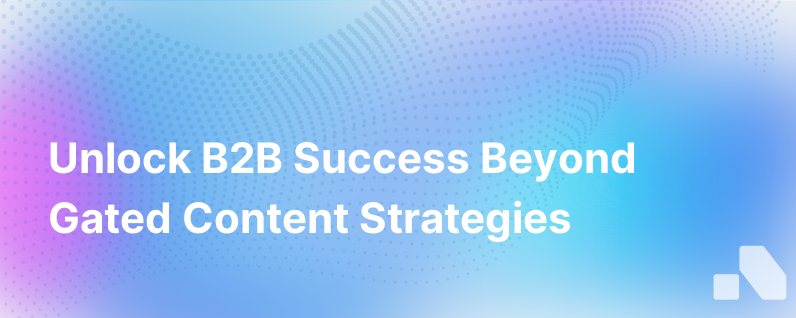
In an age where information is just a click away, creating a seamless and engaging digital experience for your B2B customers is more important than ever. One of the longstanding debates in the realm of B2B marketing is the use of gated content. While gating content might seem an effective way to generate leads, overreliance on this strategy could be costing your business valuable opportunities for connection and sales.
Let’s explore why the landscape of B2B experiences is shifting away from gated content and how embracing open access can lead to greater customer satisfaction and business success.
The Shift Away from Gated Content
Gated content is any type of content that requires the user to provide personal information, like an email address or company details, in order to access it. While gating can be a powerful tool for lead generation, the modern B2B buyer might view these barriers as a hindrance to the discovery process.
Changing Buyer Expectations
Today's B2B buyers are increasingly self-directed. They're used to having instantaneous access to the information they require to make informed purchase decisions. Gating content interrupts this flow and often leads to frustration. In response, companies are recognizing the imperative to adapt by offering value freely and upfront, thus fostering goodwill and trust among prospective clients.
Elevated Content Competition
Content marketing has exploded, resulting in an environment saturated with free resources. When faced with the decision to provide personal information or move on to the next freely available piece of content, many choose the latter. Realizing this, savvy B2B marketers are leveraging ungated content as a way to stand out from the competition.
Demand for Demonstrable Expertise
Providing content openly allows your company to showcase its expertise and thought leadership without preconditions. This transparency can position your company as a helpful and knowledgeable authority in your industry, building credibility that cannot be earned through a lead capture form alone.
Quality Over Quantity in Lead Generation
A counterintuitive benefit of ungating content is the potential for higher quality leads. When content is freely available, the contacts that do opt to engage with your company or sign up for more information are often further along in their buyer’s journey and may have a higher intent to purchase.
Benefits of Ungated Content for B2B
Unrestricted access to resources reflects a customer-first approach, aligning with current B2B buyer preferences. Here are some of the advantages of adopting an open content strategy:
Enhanced Brand Perception
By offering content without barriers, your brand is perceived as more customer-centric. This approach aligns closely with the values of transparency and generosity, which can boost brand reputation and affinity.
Increased Content Reach and Engagement
Ungated content has the potential to be shared more widely, reaching a broader audience and generating more engagement. This not only increases brand visibility but also has positive implications for SEO as more backlinks to your content are likely to be created.
Accelerated Trust Building
Trust is the cornerstone of any business relationship, especially in the B2B sector, where decisions can have considerable consequences. Sharing knowledge freely helps to establish trust earlier in the customer relationship, which is vital for nurturing leads and closing deals.
Deeper Customer Insights
Ungated content can still provide valuable insights into customer behavior and preferences. By analyzing consumption patterns and engagement metrics, your company can fine-tune its content strategy and better tailor follow-up communications.
Integrating Ungated Content into Your B2B Strategy
To benefit from ungated content while still capturing lead data when appropriate, consider adopting a balanced approach that includes both gated and ungated assets.
Offer a Mix of Gated and Ungated Content
Create a resource ecosystem with a variety of access points. Easy-to-consume top-funnel content such as blogs, infographics, and industry news can be left ungated to drive traffic and interest, while more comprehensive resources like detailed guides and reports could be gated for those further down the funnel who are more willing to exchange their information.
Use Progressive Profiling
If you do gate some content, employ a progressive profiling strategy. Ask for basic contact information initially, and progressively capture more details as leads engage with additional content over time. This gradual approach feels less intrusive to the user and lessens the friction typical of form fills.
Focus on Value Creation
Whether content is gated or not, the focus should always be on providing value. By consistently offering high-quality, relevant content, you demonstrate your commitment to serving your audience's needs, regardless of where they are in the buying process.
Leverage Social Proof and Sharing
Encourage users to share content and provide social proof that enhances the credibility of your brand. Testimonials, case studies, and user-generated content can serve as powerful, ungated endorsements of your company’s products or services.
Monitor and Adapt
Pay close attention to how your ungated content performs. Regularly review engagement metrics, track conversions, and refine your strategy to optimize the effectiveness of your content.
Conclusion
In conclusion, the trend toward ungated content reflects a broader shift in B2B buyer expectations and a growing imperative for brands to offer a more open, transparent, and customer-centric experience. By strategically integrating ungated content into your marketing efforts, you can build a stronger brand, foster trust, and engage your audience more effectively.